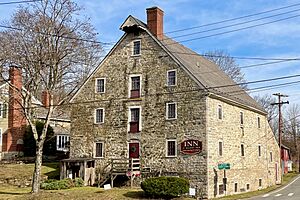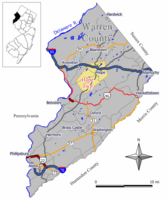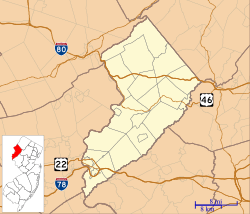Hope Township, New Jersey facts for kids
Quick facts for kids
Hope Township, New Jersey
|
|
|---|---|
|
Township
|
|

Moravian Grist Mill in Hope, now the Inn at Millrace Pond
|
|

Location of Hope Township in Warren County highlighted in yellow (right). Inset map: Location of Warren County in New Jersey highlighted in black (left).
|
|

Census Bureau map of Hope Township, New Jersey
|
|
| Country | |
| state | |
| County | |
| Incorporated | April 8, 1839 |
| Government | |
| • Type | Township |
| • Body | Township Committee |
| Area | |
| • Total | 18.29 sq mi (47.38 km2) |
| • Land | 18.08 sq mi (46.83 km2) |
| • Water | 0.21 sq mi (0.55 km2) 1.15% |
| Area rank | 155th of 565 in state 11th of 22 in county |
| Elevation | 436 ft (133 m) |
| Population
(2020)
|
|
| • Total | 1,835 |
| • Estimate
(2023)
|
1,851 |
| • Rank | 492nd of 565 in state 21st of 22 in county |
| • Density | 101.5/sq mi (39.2/km2) |
| • Density rank | 541st of 565 in state 20th of 22 in county |
| Time zone | UTC−05:00 (Eastern (EST)) |
| • Summer (DST) | UTC−04:00 (Eastern (EDT)) |
| ZIP Code |
07844
|
| Area code(s) | 908 |
| FIPS code | 3404133060 |
| GNIS feature ID | 0882242 |
Hope Township is a small community in Warren County, New Jersey. It is a type of local government called a township. In 2020, about 1,835 people lived there.
Hope Township became an official township on April 8, 1839. It was formed from parts of Knowlton Township and Oxford Township. Later, in 1926, Liberty Township was created from some of Hope Township's land.
Contents
History of Hope Township
Hope Township is one of the oldest planned communities in the United States. It was started by a German religious group called the Moravians in 1769. They carefully planned where streets, homes, businesses, and a church would be.
Before the Moravians arrived, there wasn't a town here. Just a few families farmed nearby. Moravians from Bethlehem, Pennsylvania, often stayed with a local family while traveling. This family was impressed by their way of life.
Who Were the Moravians?
The Moravians were a Christian group also known as the "Unity of the Brethren." They followed the teachings of Jan Hus, a reformer from Prague who lived in the 1400s. They faced challenges for their beliefs.
In the late 1600s, they found safety on the lands of Count Nicolas Ludwig von Zinzendorf in Germany. This place, called Herrnhut, became a worldwide center for their religion. The Moravians were known for their missionary work.
Naming the Community
After surveying the area, the Moravian Church officially accepted the community in 1774. On February 8, 1775, they changed its name from Greenland to Hope. The name "Hope" came from the early settlers' "hope of immortality."
Why the Moravians Left Hope
After almost 40 years, the Moravian community in Hope was sold. Most Moravians moved back to Bethlehem or Nazareth, Pennsylvania. The main reason was that the community was not making enough money to support itself. Its population also dropped. The church in Germany could no longer afford to support such a small village.
Geography and Location
Hope Township covers about 18.29 square miles (47.38 square kilometers). Most of this area is land, with a small amount of water. The township is located in the Kittatinny Valley. This valley is part of a much larger valley system called the Great Appalachian Valley.
Communities in Hope Township
Several smaller communities are located within Hope Township. These include:
- Hope CDP
- Mount Hermon
- Silver Lake
Other small places in the township are Feebletown, Locust Lake, Mount Herman, and Swayzes Mill.
Neighboring Towns
Hope Township shares borders with several other towns in Warren County. These are:
Population Data
| Historical population | |||
|---|---|---|---|
| Census | Pop. | %± | |
| 1840 | 1,903 | — | |
| 1850 | 1,755 | −7.8% | |
| 1860 | 1,789 | 1.9% | |
| 1870 | 1,542 | −13.8% | |
| 1880 | 1,569 | 1.8% | |
| 1890 | 1,332 | −15.1% | |
| 1900 | 1,144 | −14.1% | |
| 1910 | 1,119 | −2.2% | |
| 1920 | 948 | −15.3% | |
| 1930 | 553 | * | −41.7% |
| 1940 | 646 | 16.8% | |
| 1950 | 681 | 5.4% | |
| 1960 | 833 | 22.3% | |
| 1970 | 1,140 | 36.9% | |
| 1980 | 1,468 | 28.8% | |
| 1990 | 1,719 | 17.1% | |
| 2000 | 1,891 | 10.0% | |
| 2010 | 1,952 | 3.2% | |
| 2020 | 1,835 | −6.0% | |
| 2023 (est.) | 1,851 | −5.2% | |
| Population sources: 1840–1920 1840 1850–1870 1850 1870 1880–1890 1890–1910 1910–1930 1940–2000 2000 2010 2020 * = Lost territory in previous decade. |
|||
In 2010, Hope Township had 1,952 people. This was the highest population recorded since 1840. By 2020, the population had slightly decreased to 1,835.
Education in Hope Township
Hope Township has its own school district. Students from pre-kindergarten through eighth grade attend Hope Township Elementary School. In the 2020–2021 school year, there were 115 students and 16.2 teachers. This means there were about 7 students for every teacher.
For high school, students from Hope Township go to Belvidere High School in Belvidere. This high school also serves students from Harmony Township and White Township.
Students in Warren County can also choose to attend special schools. These include Ridge and Valley Charter School for grades K-8. For grades 9-12, students can go to Warren County Technical School.
Transportation

Hope Township has many miles of roads. Some are maintained by the township itself. Others are looked after by Warren County or the state of New Jersey.
Interstate 80 is a major highway that runs through the township. You can get on or off it at Exit 12. Other important roads include County Route 521 and County Route 519.
Notable People
Many interesting people have connections to Hope Township:
- Abraham H. Albertson (1872–1964) was a famous architect in Seattle.
- John Insley Blair (1802–1899) was a very wealthy businessman. He was known for building railroads and giving to charity.
- Charles Ferren Hopkins (1842–1934) was a Civil War soldier. He was the last surviving Union soldier in New Jersey to receive the Medal of Honor.
- Joseph Krumgold (1908–1980) was an author and screenwriter. He was the first writer to win two Newbery Medals for children's books.
Points of Interest
- Land of Make Believe is a fun amusement park. It opened in 1954 and is designed for younger children.
Surrounding Communities
 |
Blairstown Township | Frelinghuysen Township |  |
|
| Knowlton Township | Independence Township | |||
| White Township | Liberty Township |
See also
 In Spanish: Municipio de Hope (Nueva Jersey) para niños
In Spanish: Municipio de Hope (Nueva Jersey) para niños





